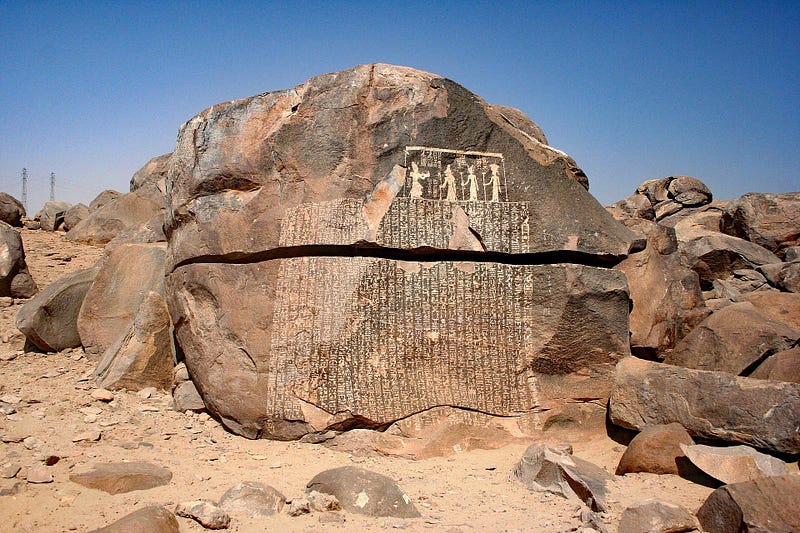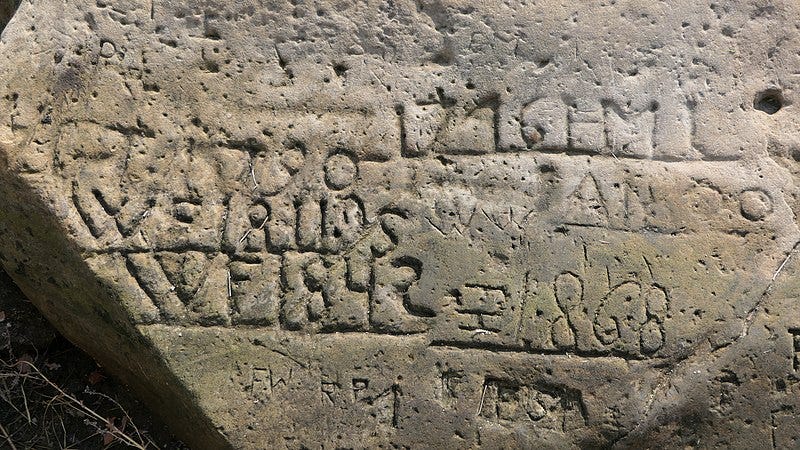Hunger Stones and Long Time
How can a deeper view of time save us from disaster?

What fascinates us about things that are hidden? What entices us about the edge between the known and the unknown? Throughout history, human beings take note of patterns that emerge in the world around us, and even more note of those instances where breaks in a pattern form. We seek out abnormalities, edges, oddities. And we pass information on to our inheritors, marking our presence in a strange and mythic place, laying claim to the abnormalities of our time.
When droughts occur, rivers shrink, and thinks that were hidden reveal themselves. Strange shapes loom up from the depths and breach the air for the first time in decades or centuries. Rocks, old buildings, petrified trees. These relics of an underworld state remind us of hard times that came before, remind us that famine and hardship are upon us… but so, too, that famine and hardship will go away again.
Over the centuries, we mark these protruding markers as they arise, taking part in the collective task of charting our history. It seems that we do this both for our children’s children, so they might be forewarned of hardships to come, and also for ourselves, as reminders that we survived these times in the past, and we may survive them again. These markers have become known as “hunger stones,” reminders that, when last the water levels came so low, famine followed. This “phenomenon of drought has become the most prominent manifestation of climate change in central Europe,” as visible through a historical exploration of the Hunger Stones spread throughout European rivers (Elleder et al., 2020, p. 1822).

For centuries or more, we’ve marked the approach of famine for our children’s children’s sake. We clearly, as a species, care deeply for the survival of those who come after us. We have an instinct toward responsibility of some sort, if only as part of a mythic undertaking that gives form to something larger than ourselves. And yet, we fail to do the same for modern trials: the great famines to come will overshadow those of centuries past. For some parts of the world, this terror has already come.
In his book, The Clock of the Long Now, Stewart brand writes, “Nobody can save the world, but any of us can help set in motion a self-saving world — if we are willing to engage the processes of centuries, because that is where the real power is.”
The ability to think in terms of centuries, to imagine the realms of the unquiet future, is one of humanity’s defining traits. Yet, somehow, this ability is dulled in modernity, dulled and diluted so that even those who do speak out go as unheeded as the street corner madman used to be. But this is not a matter of insanity, the droughts to come are not an insane call of “The End is Nigh!” We face real change, real famine, real terror. California’s rice harvest in 2022 was half of what it normally produces, and a world food crisis is looming. These are simple realities of corporation-caused climate crisis, and wars of conquest like Russia’s invasion of Ukraine.
Humanity’s hunger stones are clearly visible, and are getting more visible all the time, and yet a vast majority of people struggle to believe that change is coming — even as it sidles up and increases the immediate and personal cost of their lives.
What can be done?

I’m curious about the future, and about the ways our species will adapt to our shifting place in this vast ecosystem on which we depend. In less than a hundred years, we’ve seen unprecedented changes occur. From a dramatic surge in population, to the harnessing of the incredible power of machines; humanity is at a different point in history than ever before. There are good things and bad things about this. Hopes and terrors, both swimming in the same pool.
I think we can live to see a world changed for the better, though at this point we must recognize that our damage to the climate will have repercussions, no matter what we do. The simplest way forward would be the realization that our systems of exploitation, of finance, of economic theory — are all make-believe. If we remember that we invented this game, remember that the operation of our societies is not due to some fixed process of physics, but is actually our own devising… then we can make any change we want, occur.
I can’t say I find that very realistic, however, if only because the vast majority of people are caught within the net of their own lives. These are nets cast intentionally by the powerful and the greedy, by people who own the means of production and want to keep the status quo intact.
We might need to think as Brand suggests, and cast our thoughts into the far future; we need to create a new mythic sense of our place in space and time. Our place in the universe. But how do we get there when the gatekeepers of power have called out the guards? When the education needed to step beyond one’s personal comforts and family-systems is denied?
As always, my answer is simple: talk to people, build community. Try to avoid reactivity. Talk to your neighbors, invite them over for a glass of beer or wine. Ask them what they think about the big things in life. Listen more than you speak. Build stable connections that can stand the test of time. Currencies fade, great governments are relegated to history books, and the wealthiest charlatans will eventually become decayed flesh and bone. But the systems of human relationship vibrate on through the centuries, and these vibrations carry the tune of change.
Source References:
Stewart Brand, and Stewart Brand. The Clock Of The Long Now: Time And Responsibility. Jan. 1999.
Elleder, Libor, et al. “Low Water Stage Marks on Hunger Stones: Verification for the Elbe from 1616 to 2015.” Climate of The Past, vol. 16, no. 5, 2020, pp. 1821–46, https://doi.org/10.5194/cp-16-1821-2020.
